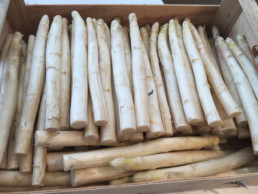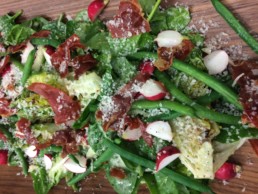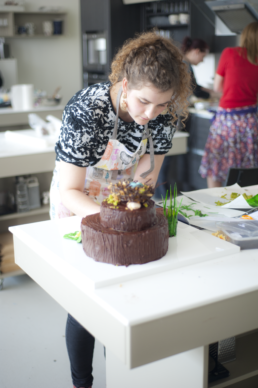May article for Cambridge Magazine
May, infused with the heady scent of lilacs, heralds the arrival of tender produce such as fresh peas, broad beans, radishes, rhubarb and the sublime Jersey Royal potatoes.
Crab is at its best and lamb adorns most menus. The concept of eating lamb early in the season, for Easter and in early May, derives from the fact that lambs were traditionally born in late winter, so they could eat the new grass as soon as they’d finished their mother’s milk. The sweetest and tenderest was spring or new lamb fed only on its mother’s milk. “Spring” means an animal born early in the same year, and slaughtered at about four months.
Lamb sold as early as Easter will have been born in midwinter, and “finished” on a diet of hay or a cereal-based manufactured feed. The wise cook will wait for the arrival of June and July to cook lamb. This will mean that the animals were reared first on mother’s milk, then from 4-5 weeks on fresh grass. Grass-fed meat is healthier than cereal fed. It is lower in fat and higher in Omega 3.
Long celebrated in France, we are catching up on the delicacy that is salt marsh lamb, usually from north Wales but increasingly also from the Essex marshes. Born between March and April, the animals graze on the estuary salt marshes and coastal pastures that are flooded by the spring tides and doused by the sea. The lambs feed on plants and minerals growing in the salt marshes which results in richly flavoured meat with a hint of samphire and sea lavender. The iodine-rich content of these plants and grasses also infuse the muscle cells in the flesh so the meat is juicier and more tender. The added benefit is that the salty water kills a large number of bacteria that can be harmful to sheep and so the need to treat the animals with chemicals is considerably reduced.
So don’t rush out to buy lamb quite yet, wait another month or so and seek out Romsey or Welsh salt-marsh lamb just in time for the barbecue season.
When I first saw sheep grazing so close to the sea I wondered how they kept from being caught up in incoming tides. I have since learnt that older ewes sense when the tide is coming in and lead the flock to higher ground and then when the tide goes out, lead the flock back to the marshes. Clever girls.
Having eaten my fill of local asparagus thoughout the month of April, I am ready to turn my attention to one of the most delicious things to come out of the earth – new potatoes from the steep slopes of Jersey. I grew up in Scandinavia, where the humble potato is a staple of the cold climate diet. New potatoes come into season a good 5-6 weeks later than in the UK, at the height of mid summer. As a result of the very long days, the flavour is exceptional. The closest thing to it in flavour are Jersey Royals. They don’t need much done to them – they should be enjoyed in their purest form. Simmered, scrubbed skin on, in well salted water and served with dollops of butter they are quite simply one of the most moreish things one could possibly eat. Roasted in olive oil, with sea salt, rosemary and lemon zest they make the perfect accompaniment to any roast fish, fowl or four legged. Simmered, then roughly crushed, or smashed, with a fork, with added butter, salt and pepper, and served with a freshly made chive or dill oil, they are a wonderful companion for smoked, grilled or pan fried mackerel.
For those preferring to put a bit more effort into their cooking, spring Bubble & Sqeak should satisfy. Mix finely chopped, cooked new potatoes with chopped spring onions, tender double podded broad beans – that is, outer grey-ish “jacket” encasing each bean removed to expose the emerald green inner bean – green peas, dill or parsley. Season well, shape into small patties and fry in sunflower oil and a little butter until crisp. I would serve with a very soft poached egg.
Radishes should be enjoyed as fresh as possible, while retaining their crispness and heat. They look and taste lovely, thinly sliced in green salads or presented simply, in a bunch, with their foliage still on. In the café we currently top our popular open rye sandwiches with Danish “Summer Salad” – sliced radishes, chopped chives and cucumber stirred into thick yoghurt and seasoned with a little lemon juice, sea salt and pepper. But, the simplest is often the best: on the first hot day, have them for lunch, paired with dense, dark Pumpernickel, cold butter, sea salt and a fridge-cold bottle of salty lager.
.
Seasonal lamb recipes
November 25, 2016
Nature Nuture
June 19, 2016
The Big Build May 1st
May 2, 2015
Cambridge BakeOff winner 2014
April 8, 2014




